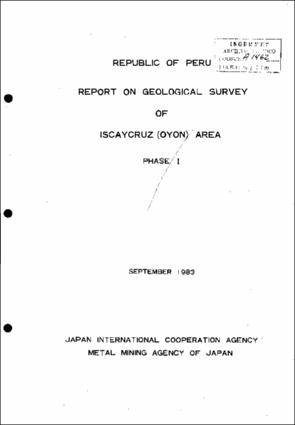- Repositorio Institucional INGEMMET
- Estudios e Informes técnicos
- Estudios y trabajos de investigación
Please use this identifier to cite or link to this item:
https://hdl.handle.net/20.500.12544/4450Report on geological survey of Iscaycruz (Oyon) area: Phase I
Sep-1983
This report summarizes results of the first year's work of the Cooperative Basic Geological Survey for Development of Mineral Resources carried out in the Iscaycruz Area, the Republic of Peru. The purpose of this project is to examine relationship between geological structure and mineralization, and to confirm lateral and vertical continuity of the mineralized zone, by means of drilling exploration and tunnelling exploration in this area. The Iscaycruz Area had been extracted as a favorable area where economic ore deposits would be expected to be emplaced, by the results of the Cooperative Basic Geological Survey for Development of Mineral Resources in the Oyon Area, which was carreied out during the period of three years from 1979 to 1981. The Iscaycruz Area is located about 150 km north of Lima, in the backbone range of the West Andes. Geologically, Mesozoic sedimentary rocks are widely distributed in this area, forming remarkable compose folded structure due to tight folding with the axes in the Andean direction, namely NNW-SSE. The Iscaycruz mineralized zone is located approximately 7 to 19 km south-southeast of Oyon, in the high mountain at the altitude of 4,700 m above sea level. The mineralization occurs in the limestones of the Santa Formation, about 40 to 80 meters in thickness, and continues about 12 km along the strike. In this mineralized zone there are two types of ore deposits; the one is contact metasomatic skarn type ore deposits represented by copper-zinc skarn orebodies and the other is hydrothermal replacement ore deposits represented by copper-lead-zinc massive sulphide orebodies as well as by disseminated orebodies of lead and zinc in the siderite beds. In this year's program in the Limpe area, where high grade copperlead- zinc ore deposits would have been expected, diamond drilling of five holes was performed at five localities, the total length of which was 1,300 m, while the tunnelling exploration was carried out at two localities in different two levels, whose total excavated length was 580 m. By the results of the diamond drilling, the existence of high-grade copper ores accompanied by pyrite mass and lead-zinc orebodies have been confirmed in the drill hole IC-2, which is located near Cumbre de Limpe. The copper ores are recognized in two parts of total core length of 24.8 m. with the average grades of Ag: 43 g/t and Cu: 4.38 %, while the lead-zinc ores are found in four parts of total core length of 53.3 m with the average grades of Ag: 23 g/t, Pb: 2.81 % and Zn: 15.07 %. By the diamond drillings located to the south of Cumbre de Limpe, it has been confirmed that pyrite and hematite are predominant as ore minerals in this area, partly with heavy concentration of copper minerals in this area. As for the tunnelling exploration, two tunnels which were worked in this year of the program have not reached the mineralized zone in the Santa Formation. Both of the tunnels, Adit-N (elevation: 4,690 m) and Adit-S (elevation: 4,570 m), were excavated in the quartzite beds in the Chimu Formation. For future program of the investigation in the Limpe area where the most favorable indications of mineralization warranting further exploration have been confirmed, it is recommended to keep proceeding the exploration by tunnelling and to carry out underground diamond drilling, with the purpose to make clear the details of the figures and the conditions of the mineralized zone geologically, as well as to undertake full examination of the features of the mineralized zone in the deeper part.
Japan International Cooperation Agency | Metal Mining Agency of Japan
Files in This Item:
| File | Description | Size | Format | |
|---|---|---|---|---|
| JICA-Report_geological_survey_Iscaycruz-Phase1.pdf | Reporte | 2.99 MB | Adobe PDF | View/Open |
This item is licensed under a Creative Commons License












